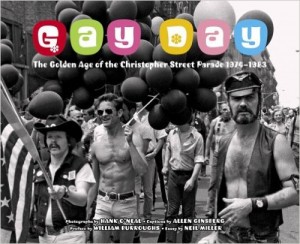 Gay Day: The Golden Age of the Christopher Street Parade, 1974-1983
Gay Day: The Golden Age of the Christopher Street Parade, 1974-1983
Photographs by Hank O’Neal; captions by Allen Ginsberg;
preface by William S. Burroughs; essay by Neil Miller
Abrams Image. 160 pages, $24.95
IN THE OLD DAYS of television, the late comedian Steve Allen had a regular routine on his show in which he would set up a camera at the corner of Hollywood and Vine in Los Angeles and make funny comments about the people who passed by. Allen Ginsberg’s captions for Gay Day, a coffee table book of black-and-white photographs of the Gay Pride Day Parade in New York City, are reminiscent of that. “Allen [Ginsberg] would look at a photograph,” writes Hank O’Neal in his introduction for the book, whose title was coined by Ginsberg, “and as he thought about the image and responded to it, would simply write down the first thing that came to his mind.”
Alas, Ginsberg’s captions are neither as clever nor as humorous as Steve Allen’s quips were, and they add little to our understanding of what it was like to be a gay man during the years in question, 1974 to 1983. In fact, the captions come off as a bit off-the-wall. If anything they get in the way of one’s enjoyment and contemplation of the pictures. For example, a bald, bare-chested man walking beside his bicycle is described by Ginsberg as “ A spy from the moon with his motorcycle wired up as erotic transmitter to 7th Heaven (the beams bounce off his skull into outer space).” I guess it helps to be in a chemically altered state of mind to understand that one. Gay Day put me in mind of the wonderful picture book Langston Hughes and the photographer Roy DeCarava collaborated on around 1955 called The Sweet Flypaper of Life. That book, a fictional story built around a series of photos of a black family in Harlem, is heartwarming and memorable. This might have been a good route for O’Neal to have taken. A meaningful meditation on the parade would have been quite fitting.
The photos have frozen time and given us the opportunity to see what gay men looked like and how they dressed in those early years of the parade. The most striking thing about the photos is how white and how male the crowd was compared to today—not to mention how much facial and body hair so many of the men sported! It’s truly amazing how few women and people of color are seen in the parade and on the sidelines. It makes me wonder what the state of racial and gender relations were in the New York gay community at the time. Unfortunately, there’s not much variety in the location of the photos, which were taken for the most part near Sheridan Square, a gay crossroads, where 7th Avenue South cuts across Christopher Street. The second photo in the book is of the intersection with a huge billboard advertising Marlboro cigarettes above the Village Cigars storefront. Ginsberg’s penciled caption states (facetiously I assume): “Gay Pride begins at the center of the official U.S. Dope Trade.” It’s as though the photographer was afraid to step outside of his comfort zone.
The fact that the photographer is a straight man and admittedly “something of an outsider” may have something to do with how the parade was photographed. After all, the camera lens is an extension of the eye and mind of the photographer, who reveals his own sensibilities by what he chooses to capture on film. I wanted to see pictures of activity in the side streets and in front of places like the bars and the Oscar Wilde Bookstore, and especially on the piers. A gay photographer might have gotten a broader and a more revealing portrait. At any rate, these pictures don’t tell us much about this so-called “golden age.” The most amusing and noteworthy photo is one taken in 1978 of a storefront window that displayed a placard entitled the “S&M Hanky Color Code,” which informs us, for example, that a green handkerchief worn in the left back pocket means the wearer is a “Hustler, Selling,” while one in the right pocket is a “Trick, Buying.” This photo is so self-explanatory that even Ginsberg saw no need to comment.
As one who witnessed many gay parades in the Village beginning in 1983 (the last year that the pictures in the book were taken), I found that the scene away from the parade route was at least as fascinating as the main drag. But for all that, Gay Day does take the reader to a time before the scourge of AIDS decimated a generation of gay men and offers a glimpse into how GLBT people flaunted and celebrated their gay pride in this famously “innocent” period of our history.
____________________________________________________________________
Charles Michael Smith is a freelance writer living in New York City.





